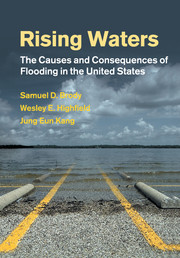Book contents
- Frontmatter
- Contents
- Preface
- Acknowledgments
- Abbreviations
- 1 Introduction: rising waters
- Part I The consequences of floods
- 2 Rising cost of floods in the United States
- 3 Impacts of flooding in coastal Texas and Florida
- 4 National and state flood policy mitigation in the United States
- Part II Planning decisions and flood attenuation
- Part III What are we learning?
- Part IV Policy implications and recommendations
- 12 Conclusions
- References
- Index
4 - National and state flood policy mitigation in the United States
from Part I - The consequences of floods
Published online by Cambridge University Press: 28 April 2011
- Frontmatter
- Contents
- Preface
- Acknowledgments
- Abbreviations
- 1 Introduction: rising waters
- Part I The consequences of floods
- 2 Rising cost of floods in the United States
- 3 Impacts of flooding in coastal Texas and Florida
- 4 National and state flood policy mitigation in the United States
- Part II Planning decisions and flood attenuation
- Part III What are we learning?
- Part IV Policy implications and recommendations
- 12 Conclusions
- References
- Index
Summary
In an attempt to mitigate the mounting losses caused by floods, which total billions of dollars of damage in the U.S. every year (as outlined in the previous two chapters), federal, state, and local governments have implemented a range of regulatory and policy mechanisms. These policies range from indirect attempts to reduce flood damage through local and state-level planning initiatives to very specific and direct mitigation activities to cover and avoid losses at the federal level. As flood damages and attention to flood events have increased, so too have the attempts to mitigate losses through policy initiatives. However, the steps taken to reduce flood damages are not necessarily evenly implemented across all jurisdictions. Many direct flood mitigation policies are applied by way of a “carrot approach,” where actions are not required, but instead provide some form of incentive to communities and households.
In this chapter, we present and discuss the major policy-driven flood mitigation activities and opportunities in the U.S. and specifically for our study states of Texas and Florida. We provide snapshots of the mitigation steps communities are taking through policy tools available to them at multiple jurisdictional levels. When possible, we also summarize and compare the status of flood mitigation among local communities in Texas and Florida. This chapter follows a top-down logic for describing programs and policies available for flood mitigation.
- Type
- Chapter
- Information
- Rising WatersThe Causes and Consequences of Flooding in the United States, pp. 56 - 68Publisher: Cambridge University PressPrint publication year: 2011



